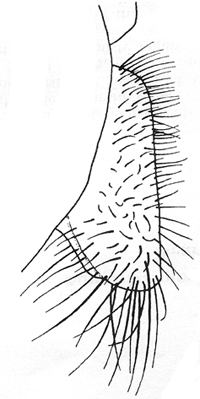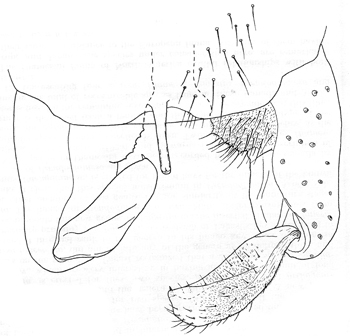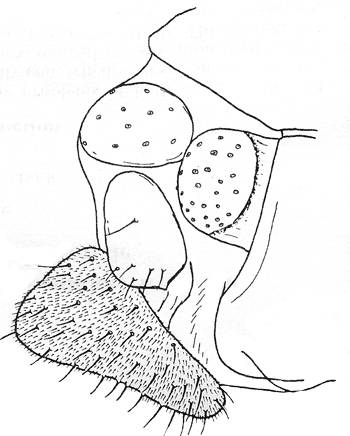 Aquatic Insects of Michigan
Aquatic Insects of Michigan
by Ethan Bright, Museum of Zoology Insect Division and School of Natural Resources and Environment
University of Michigan
- Home
- Species Lists
- Coleoptera
- Diptera
- Ephemeroptera
- Acanthametropodidae
- Ameletidae
- Ametropodidae
- Arthropleidae
- Baetidae
- Baetiscidae
- Behningiidae
- Caenidae
- Ephemerellidae
- Ephemeridae
- Heptageniidae
- Isonychiidae
- Leptohyphidae
- Leptophlebiidae
- Metretopodidae
- Neoephemeridae
- Oligoneuriidae
- Palingeniidae
- Polymitarcyidae
- Potamanthidae
- Pseudironidae
- Siphlonuridae
- Heteroptera
- Hymenoptera
- Lepidoptera
- Megaloptera
- Neuroptera (Sisyridae)
- Odonata
- Orthoptera
- Plecoptera
- Trichoptera
- Other Orders
- Keys/Identification
- Aquatic Insects of Michigan
Pagastia Oliver, 1959
One species is currently known from Michigan, Pagastia orthogonia Oliver, which is the type species for the genus. Adult and larval descriptions are from Oliver (1959) and Oliver and Roussel (1982), respectively.
Male imago. Head: Eyes: bare, dorsally produced around the antennal bases. Temporal hairs: numerous, reaching to almost the midline of the head. Palps four segmented. Antennae: 14 segmented, highly plumose, terminal segment with strong subapical ahir. Pronotum: well-developed, lobes divided by a V-shaped incision, long hairs on at least the dorsomedial and ventrolateral margins. Aerostichial bristles: long, not reaching anteriorly to the pronotum. Dorsocentral bristles: 2 to 5 irregular rows, number or rows increase posteriorly. Supraalar bristles: extending foreward to almost humeral caIIus. Scutellum: well
covered with hairs. Wings: surface bare or with microtrichia on tip, microtrichia
present, costa strongly produced past R
anteriorly to the pronotum. Dorsocentral bristles: 2 to 5 irregular rows, number or rows increase posteriorly. Supraalar bristles: extending foreward to almost humeral caIIus. Scutellum: well
covered with hairs. Wings: surface bare or with microtrichia on tip, microtrichia
present, costa strongly produced past R4+5, ending in costa about midway between R1 and R4+5, distance between r-m and base of M3+4 greater than the length of the base of M3+4, base of M3+4 slightly distal to the posterior fork, anal lobe somewhat produced, squama with thick fringe of hairs. Legs: fourth tarsal segments all cylindrical: foretibia with single spur, slightly longer than
diameter of foretibia end; middle and hind tibia with two spines, those of the middle tibia subequal, those of the hind tibia unequal, lateral about 2/3 length of the medial; fore tarsal segments with or without apical spines; first two tarsal segments of the middle and hind legs each with two apical spines; pulvilli absent. Hypopygium: anal point long, broad inner lobe of coxite divided by a heavy chitinized band into a proximal bare (dorsally) part and a hairy distal part.
Pagastia orthogonia Oliver
Male imago. Entirely black, thorax heavily pruinose. Antennae: second segment with a single hair whorl, segments 3-13 each with a double hair whorl. Pronotum: long hairs on the dorsomedial and ventrolateral margins. Acrostichial bristles: long, erect, beginning about 1/5 the distance along the mesonotum from the pronotum. Scutellum: 5-6 rows of bristles medially converging to 2-3 laterally. Wings: tips of cells r5 and m2 with few macrotrichia. Dorsal abdominal chaetotaxis: uniform with small anterolateral bare areas.  Hypopygium: anal point long, parallel-sided, apically bluntly rounded; coxite normal; stylus rather straight with a short terminal spine. Wing length: about 3.9 mm. AR: 1.37-1.95 (n = 5) . LR: 0.73-0.78 (n = 5).
Hypopygium: anal point long, parallel-sided, apically bluntly rounded; coxite normal; stylus rather straight with a short terminal spine. Wing length: about 3.9 mm. AR: 1.37-1.95 (n = 5) . LR: 0.73-0.78 (n = 5).
 Female imago. Identical to males except for usual femal female differences, but should be taken in copulation for positive identification. Antennae: 7-segmented. Wings: with more macrotrichia than males, extending proximally about 1/3 the length in cells r5 and m2. Genitalia: as in figure; cerci triangular, projecting anteriorly; lobe dorsal to cerci rounded, not projecting over the cerci as in Pseudodiamesa. Spermatheca: three, equal-sized, oval.
Female imago. Identical to males except for usual femal female differences, but should be taken in copulation for positive identification. Antennae: 7-segmented. Wings: with more macrotrichia than males, extending proximally about 1/3 the length in cells r5 and m2. Genitalia: as in figure; cerci triangular, projecting anteriorly; lobe dorsal to cerci rounded, not projecting over the cerci as in Pseudodiamesa. Spermatheca: three, equal-sized, oval.
Larva (4th instar) (From Oliver and Roussel 1982). Medium to large larvae up to 12 mm long. Body yellowish brown to greyish brown; head capsule yellow to yellowish brown with contrasting black postoccipital margin, sometimes with dark markings. Eye spot bilobed or in 2 parts. Clypeus weakly separated from frontal apotome and fused with labrum. Antenna: 5-segmented, shorter than mandibular length; segments consecutively shorter or third, fourth, and fifth subequal in length; third segment annulated and weakly separated from fourth segment. Ring organ on basal third of first segment. Blade extending to level of third segment; accessory blade slightly longer than second segment. Lauterborn organs about as long as third segment; style about as long as combined length of third and fourth segments. Labrum: Labral sclerite undivided. S I, S II, and S III simple: S IV A and S IV B peglike. Labral lamellae consisting of 1 pair of long lobes with pectinate or branched apices; chaetae with long narrow branches; chaeta media elongate with pectinate or branched apex; 5-7 pairs of pointed spinulae present. Pecten epipharyngis consisting of 3 pointed scales, lateral pair partly overlapping median scale. Four to five pairs of chaetulae laterales present, median pair broad; 2 pairs of chaetulae basales present. Ungula broadly U-shaped; basal sclerite absent. Premandible broad with 5-10 teeth and lateral spine; brush absent. Mandible: Apical tooth longer or shorter than combined width of inner teeth; 4 inner teeth present; inner teeth in row or basally appressed forming a weak compound tooth. Pecten mandibularis absent. Seta subdentalis short, apically pointed. Seta interna with 5-16 simple or serrated branches. Mentum: Apex truncated, consisting of fused ventromental plates, with ridges but without teeth. Six to eight pairs of lateral teeth present, outer lateral tooth small. Ventromental plates large, fused medially, and extending laterally and medially to lateral teeth; beard absent. Setae submenti located closer to postoccipital margin than to the mentum. Maxilla: Maxillary palp longer than wide. Palpiger with several weak triangular chaetulae, chaetulae apparently not always present. Galea with setose lamellae; pecten galearis absent. Lacina short with long overlapping chaetulae: appendix setae apparently absent. Setae maxillaris simple. Premento-hypopharyngeal complex: Four sensillae of labial palp with common base, fifth sensillurn arising separately. Ligula with numerous long thin branches. M appendage simple. Paraligulae consisting of long, narrow, and multipointed scales. Pecten hypopharyngis consisting of several transverse rows of apically serrated scales. Body: Anterior parapods separate, each bearing an apical crown of claws; longer claws weakly serrate on inner margin. Posterior parapods well developed, separate, and each bearing an apical crown of irregularly placed simple claws. Procercus slightly longer than wide, posterior margin strongly sclerotized with basal spur extending on adjacent body wall, sometimes with apical hook; 7-8 anal setae and 2 lateral setae present. Supraanal setae present. Two pairs of anal tubules present, shorter than posterior parapods; dorsal pair of tubules arising at same level: 1 tubule of ventral pair arising ventral to the other tubule.
References
-
Oliver DR. 1959. Some Diamesinae (Chironomidae) from the Nearctic and Palaerctic.Entomologisk tidskrift 80(1):48-64.
Oliver DR, Roussel ME. 1982. The larvae of Pagastia Oliver (Diptera: Chironomidae) with descriptions of three Nearctic species. The Canadian Entomologist 114:849-854.